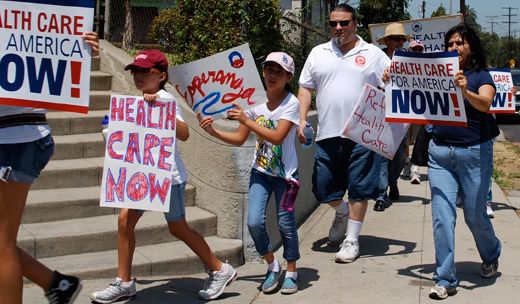
California, with the nation’s biggest insurance market, continues to lead the nation in preparing for next year’s launch of the Affordable Care Act, or “Obamacare.”
Speaking June 7 in San Jose, President Obama highlighted work in California, Oregon and Washington to prepare for implementation, and pointed out that insured Californians have already received tens of billions of dollars in rebates under the law’s requirement that insurers spend at least 80 percent of premiums on health care.
While the nearly 85 percent of Americans who already have health insurance are gaining new benefits including free preventive care and the ability to keep young people insured to age 26, the president said, uninsured Californians will soon be able to comparison-shop for quality, affordable care “just like everybody else.” Nearly half will qualify for help in paying for the coverage.
It is estimated that nearly six million Californians are currently uninsured.
“Now none of this is a surprise,” Obama said. “This is the way the law was designed to work. But since everybody has been saying how it’s not going to happen, I think it’s important for us to recognize and acknowledge this is working the way it’s supposed to.”
The president’s remarks followed the unveiling by California’s new health insurance exchange, Covered California, of tables letting consumers compare coverage and rates among insurers preparing to launch four levels of coverage plans in 19 regions of the state.
Thirteen plans were accepted to offer coverage in the state, with three to six operating in each region.
Covered California said the rates submitted by the 13 insurance carriers ranged from 2 percent higher to 29 percent lower than the average current premium of small-employer plans in the state’s largest metropolitan areas. The agency said the plans lowered their profit margins to 2 to 3 percent while negotiating lower reimbursements for hospitals and physicians.
More than 30 health plans had initially expressed interest in participating, and three of the country’s biggest insurers – UnitedHealth Group, Aetna and Cigna – decided not to participate in 2014.
While some opponents of the Affordable Care Act tried to portray Covered California’s announcement as “rate shock,” Anthony Wright, who heads the state’s broad Health Access coalition of consumer advocates, emphasized in a June 4 blog post that the rates were lower than expected. “This is partially because California explicitly gave its insurance marketplace the power to bargain for the best price and value,” he said.
In a May 29 essay for The New York Times’ Room for Debate feature, Wright called the law “a complex response to a complex problem,” and said California is already proving that “if states want it to work, it will.”
Observing that California’s size and diversity, and its high rate of uninsurance, mean the health care system is “in crisis,” Wright said that with the resulting commitment by policymakers and the public to make the new law work, “If we can do it here, we can do it anywhere.”
At the same time, Wright and other consumer advocates are warning that not all the uninsured will be able to seek coverage through Obamacare. An earlier Health Access concept paper said as many as 3 to 4 million may be left uninsured.
“The majority of the remaining uninsured will be citizens or legal residents, who will be disproportionally Latino, African American, and Asian-Pacific Islander,” Health Access said. “Some will not be eligible due to income or immigration status, for missing open enrollment periods, or due to other gaps in the law.”
Consumer advocates are urging that the state’s commitment to health care for the remaining uninsured be continued through adequate funding for the state’s safety net of public hospitals, community clinics and other providers.
Photo: California health care march. CCBYNCSA2.0










